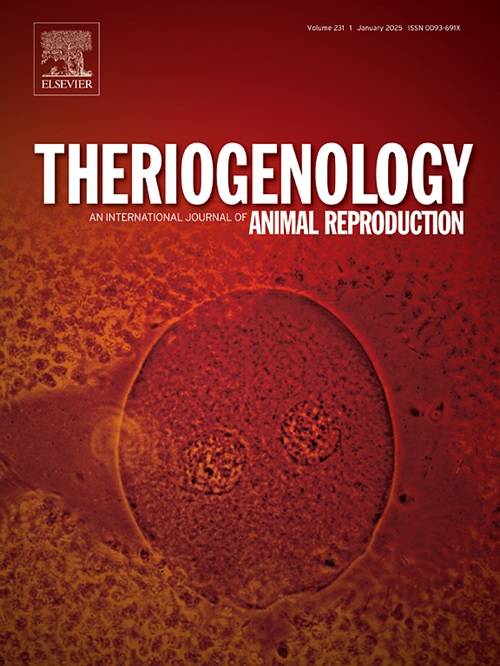IF 2.4
2区 农林科学
Q3 REPRODUCTIVE BIOLOGY
引用次数: 0
摘要
研究表明,雌二醇(E2)和孕酮(P4)对牛输卵管形态参数的改变有显著影响。通过比较发情周期不同激素阶段之间或排卵前卵泡/黄体同侧和对侧之间不同激素组合的影响,甚至黄体的大小,都证明了这些形态学变化。我们之前的研究表明,卵巢过度刺激(OVS)方案会增加排卵前期牛输卵管中的E2水平。因此,我们希望深入了解卵巢过度刺激方案对牛输卵管形态参数的影响。为此,我们的研究评估了两种OVS方案,一种是纯FSH方案,另一种是FSH/eCG方案。第三组作为对照组,不进行超级刺激(同步发情)。分别对输卵管的安瓿和峡部进行形态分析(苏木精和伊红染色-HE)、总胶原蛋白定量(皮罗西瑞红染色-PSR)、分形尺寸分析和总粘蛋白定量(周期性酸-希夫斯/阿利西安蓝染色)。总体而言,两种OVS方案都降低了峡部的粘膜高度、上皮面积和管腔面积,而胶原蛋白总量则增加了。相比之下,采用 FSH/eCG 方案的奶牛的肌层面积和安瓿粘膜高度增加,而胶原蛋白总量减少。分形尺寸分析表明,在分析用 PSR 染色的组织时,与同步组相比,两种 OVS 处理都增加了峡部和安瓿段的细胞组织。最后,与其他组相比,FSH/eCG 方案增加了峡部和安匝部粘蛋白的相对丰度。总之,我们的研究表明,经卵巢输卵管同步化治疗的奶牛表现出不同的输卵管形态表型,其特征包括形态计量学变化、胶原调节和组织化学改变。本文章由计算机程序翻译,如有差异,请以英文原文为准。
Ovarian superstimulation protocols modulate the morphological phenotypes in bovine oviduct
It has been shown that estradiol (E2) and progesterone (P4) have a significant influence on the alteration of morphological parameters in the oviduct of cattle. These morphological changes were demonstrated by comparing the effects of the different hormonal profiles between the hormonal phases of the estrous cycle or between the ipsi- and contralateral side of the preovulatory follicle/corpus luteum and even the size of the corpus luteum. In our previous study, we have shown that the ovarian superstimulation (OVS) protocol increases E2 levels in the bovine oviduct during the preovulatory phase. Therefore, we wanted to gain insight into the effects of OVS protocols on morphological parameters in the bovine oviduct. To this end, our study evaluated two OVS protocols, an FSH-only protocol and the FSH/eCG protocol, both of which were successfully standardized for Nelore cows (Bos taurus indicus). A third group was used as a control that was not superstimulated (synchronized estrus). The ampulla and isthmus segments of the oviduct were analyzed separately for morphometric analysis (hematoxylin and eosin staining – HE), quantification of total collagen (picrosirius red staining – PSR), analysis of fractal dimensions, and quantification of total mucin (staining with periodic acid-Schiffs/Alcian blue). Overall, both OVS protocols decreased mucosal height, epithelial area, and luminal area in the isthmus, while total collagen quantification increased. In contrast, cows subjected to the FSH/eCG protocol exhibited increased muscle layer area and mucosal height in the ampulla, while total collagen quantity decreased. Analysis of fractal dimensions showed that both OVS treatments increased cell organization in both isthmus and ampulla segments compared to the synchronized group when analyzing tissues stained with PSR. Finally, the FSH/eCG protocol increased the relative abundance of mucins in the isthmus and ampulla segments compared to the other groups. In conclusion, we have shown that cows subjected to OVS exhibit a different morphological phenotype in the bovine oviduct characterized by morphometric changes, collagen modulation, and histochemical alterations.
求助全文
通过发布文献求助,成功后即可免费获取论文全文。
去求助
来源期刊

Theriogenology
农林科学-生殖生物学
CiteScore
5.50
自引率
14.30%
发文量
387
审稿时长
72 days
期刊介绍:
Theriogenology provides an international forum for researchers, clinicians, and industry professionals in animal reproductive biology. This acclaimed journal publishes articles on a wide range of topics in reproductive and developmental biology, of domestic mammal, avian, and aquatic species as well as wild species which are the object of veterinary care in research or conservation programs.
 求助内容:
求助内容: 应助结果提醒方式:
应助结果提醒方式:


